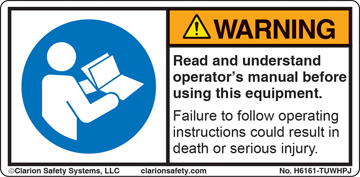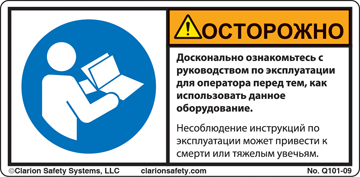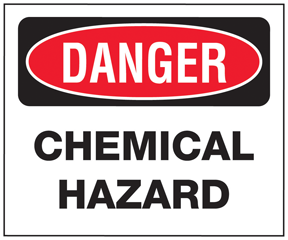Designing effective product safety labels that can help to prevent injuries and save lives is a complex task. This month, we’ll focus on one of the key elements to consider: symbols.
One of the most fundamental building blocks in designing an effective safety label may surprise you. It’s not your text, format, or signal words (although these are all key elements). With the understanding that it’s imperative for product manufacturers to communicate safety information about residual risks efficiently and effectively, and to do so in a global marketplace, it’s the symbols you place on your safety labels that have become increasingly significant.
HOW SYMBOLS ACHIEVE BASIC COMMUNICATION GOALS
When it comes to protecting your product’s users (and those that might install, service or dispose of your product), there are two basic things that your product safety labels must typically communicate:
- A description of what the hazard is (which often includes describing its seriousness and the consequence of interacting with it) and
- How to avoid the hazard.Using well-designed symbols on your labels allows you to visually communicate one or both parts of this information across language barriers.
THE IMPORTANCE OF VISUAL PERCEPTION
Yet, the primary reason to use symbols is more interesting than overcoming language barriers. Scientific research has shown that the human brain processes images far more efficiently than it processes text. The fact is, we perceive the world primarily through our sense of sight. It’s been well established that over 70% of everything we learn is learned visually. The limbic portion of our brain includes the visual system; this is our sense of sight. Even more importantly for our discussion here with regards to product warnings, it’s the limbic portion of our brain that controls our emotions and our behavior. The cerebral cortex, on the other hand, is the part of the brain that processes spoken and written language and it plays a far lesser role in our day-to-day processing of information.
The implications of this research is profound when the goal is to design effective warnings – warnings that are meant to change people’s behavior so that they make wise choices when confronted with potential hazards. When you think about it, the idea that our visual sense is hardwired in a much closer way to our behavior-making brain function makes complete sense. Ten thousand years ago, when a caveman (or should we say cave person?) saw a saber-toothed tiger coming around the bend, a quick, immediate action was required: hide, run or climb a tree! It’s the visual perception of the danger that causes us to pay attention and react. When it comes to a product’s safety labels, it’s the job of the symbols to do this same task, bringing a heightened degree of noticeability and comprehension to the label’s message.
LABELS IN FOCUS: EXAMPLES OF BEST PRACTICES
It’s important to note that, to be most effective and compliant with best practices, the symbols you use should come from the most up-to-date standards or be drawn using the latest standards-based illustration techniques. Use of these symbols and design principles should provide a sense of uniformity that, according to design theory, will aid in people’s ability to comprehend a symbol’s meaning. In other words, when it comes to graphical symbols, don’t reinvent the wheel if you don’t have to. (See the November 2012 On Your Mark column for more information on this.)
Look at Figure 1. It shows a best practice Read Manual safety label in English – with a clear and eye-catching symbol. Even if your audience does not know English, they would have an understanding of the label’s message because of the symbol. To better illustrate this, see Figure 2: a safety label in Russian, with and without a symbol. Would the label on the left stand out to you in the midst of all of the other messages you encounter in a day? Do you have any understanding of its content? Now look at the Russian label to its right, and consider the difference in noticeability. Would your attention be better drawn to this label because it has a symbol and would you now, at the least, understand a portion of the label’s message?

Figure 1: ISO/ANSI-formatted safety label in English with a symbol. (Design ©2014 Clarion Safety Systems. All rights reserved.)


Figure 2: ISO/ANSI-formatted safety label in Russian – without a symbol (at left) and with a symbol (at right). (Designs ©2014 Clarion Safety Systems. All rights reserved.)
LABELS, SYMBOLS, AND YOUR DUTY TO WARN
Now that we’ve reviewed the role that symbols play in safety communication, let’s look at this from the perspective of providing a legal defense for your company should an accident occur and your product’s safety label is challenged. While product liability laws vary from state to state, one principle holds true: your duty to warn revolves around your ability to provide adequate warnings and instructions for the safe use of your products. If you provide warnings on your product, the court will typically grant you the assumption that warnings would have been read and heeded by a reasonable person. The more that you can make your warning reasonably understandable by the widest possible audience (including non-English speakers), the better off your position will be in court if you are required to defend your warnings. In this way, adding graphical symbols to your safety labels not only protects the user of your products, it also protects your company. Figure 3 is an example of a best practice ISO/ANSI-formatted safety label that uses ISO symbols to both describe the hazard and define the avoidance procedure. If your product needed a safety label to communicate this message, the ISO/ANSI-formatted label will accomplish your goals of improved product safety and reduced product liability exposure far better than its predecessor (shown in Figure 4).

Figure 3: ANSI Z535 chemical hazard safety label with ISO-formatted symbols. (Design ©2014 Clarion Safety Systems. All rights reserved.)

Figure 4: Old safety label design.
Both national and global best practices dictate that, as the product manufacturer, you should provide warnings on products that have residual risks. The use of graphical symbols to help accomplish this task is highly encouraged in many regulations and standards. Rarely, though, are the actual label design specifications defined. This means you have options to choose from when it comes to how best to integrate symbols and text to convey your safety message.
The next On Your Mark column will explore the layout choices you have to combine text and symbols to best accomplish the goal of effective safety communication.
 For more information on best practices related to ISO symbols, watch a short, educational video produced by Clarion Safety Systems.
For more information on best practices related to ISO symbols, watch a short, educational video produced by Clarion Safety Systems. ![]()
 |
Geoffrey Peckham Geoffrey Peckham, CEO of Clarion Safety Systems, is chair of both the ANSI Z535 Committee for Safety Signs and Colors and the U.S. Technical Advisory Group to ISO Technical Committee 145 – Graphical Symbols, and member of the U.S. Technical Advisory Group to ISO Project Committee 283 – Occupational Health and Safety Management Systems. Over the past two decades, he has played a pivotal role in the harmonization of U.S. and international standards dealing with safety signs, colors, formats and symbols. This article is courtesy of Clarion Safety Systems © 2014. All rights reserved. |
